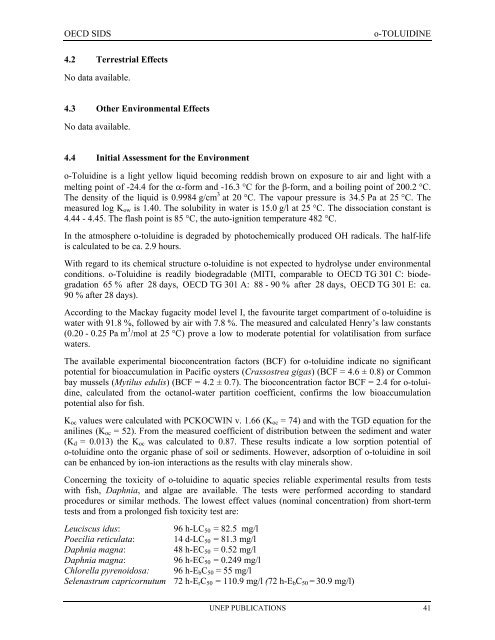o-TOLUIDINE CAS N°: 95-53-4 - UNEP Chemicals
o-TOLUIDINE CAS N°: 95-53-4 - UNEP Chemicals
o-TOLUIDINE CAS N°: 95-53-4 - UNEP Chemicals
Create successful ePaper yourself
Turn your PDF publications into a flip-book with our unique Google optimized e-Paper software.
OECD SIDS o-<strong>TOLUIDINE</strong><br />
4.2 Terrestrial Effects<br />
No data available.<br />
4.3 Other Environmental Effects<br />
No data available.<br />
4.4 Initial Assessment for the Environment<br />
o-Toluidine is a light yellow liquid becoming reddish brown on exposure to air and light with a<br />
melting point of -24.4 for the α-form and -16.3 °C for the β-form, and a boiling point of 200.2 °C.<br />
The density of the liquid is 0.9984 g/cm 3 at 20 °C. The vapour pressure is 34.5 Pa at 25 °C. The<br />
measured log Kow is 1.40. The solubility in water is 15.0 g/l at 25 °C. The dissociation constant is<br />
4.44 - 4.45. The flash point is 85 °C, the auto-ignition temperature 482 °C.<br />
In the atmosphere o-toluidine is degraded by photochemically produced OH radicals. The half-life<br />
is calculated to be ca. 2.9 hours.<br />
With regard to its chemical structure o-toluidine is not expected to hydrolyse under environmental<br />
conditions. o-Toluidine is readily biodegradable (MITI, comparable to OECD TG 301 C: biodegradation<br />
65 % after 28 days, OECD TG 301 A: 88 - 90 % after 28 days, OECD TG 301 E: ca.<br />
90 % after 28 days).<br />
According to the Mackay fugacity model level I, the favourite target compartment of o-toluidine is<br />
water with 91.8 %, followed by air with 7.8 %. The measured and calculated Henry’s law constants<br />
(0.20 - 0.25 Pa m 3 /mol at 25 °C) prove a low to moderate potential for volatilisation from surface<br />
waters.<br />
The available experimental bioconcentration factors (BCF) for o-toluidine indicate no significant<br />
potential for bioaccumulation in Pacific oysters (Crassostrea gigas) (BCF = 4.6 ± 0.8) or Common<br />
bay mussels (Mytilus edulis) (BCF = 4.2 ± 0.7). The bioconcentration factor BCF = 2.4 for o-toluidine,<br />
calculated from the octanol-water partition coefficient, confirms the low bioaccumulation<br />
potential also for fish.<br />
Koc values were calculated with PCKOCWIN v. 1.66 (Koc = 74) and with the TGD equation for the<br />
anilines (Koc = 52). From the measured coefficient of distribution between the sediment and water<br />
(Kd = 0.013) the Koc was calculated to 0.87. These results indicate a low sorption potential of<br />
o-toluidine onto the organic phase of soil or sediments. However, adsorption of o-toluidine in soil<br />
can be enhanced by ion-ion interactions as the results with clay minerals show.<br />
Concerning the toxicity of o-toluidine to aquatic species reliable experimental results from tests<br />
with fish, Daphnia, and algae are available. The tests were performed according to standard<br />
procedures or similar methods. The lowest effect values (nominal concentration) from short-term<br />
tests and from a prolonged fish toxicity test are:<br />
Leuciscus idus: 96 h-LC50 = 82.5 mg/l<br />
Poecilia reticulata: 14 d-LC50 = 81.3 mg/l<br />
Daphnia magna: 48 h-EC50 = 0.52 mg/l<br />
Daphnia magna: 96 h-EC50 = 0.249 mg/l<br />
Chlorella pyrenoidosa: 96 h-EbC50 = 55 mg/l<br />
Selenastrum capricornutum 72 h-ErC50 = 110.9 mg/l (72 h-EbC50 = 30.9 mg/l)<br />
<strong>UNEP</strong> PUBLICATIONS 41
















